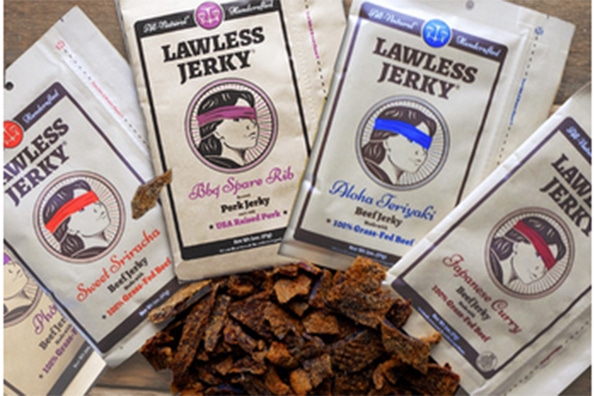March 28, 2016

 Anybody who walked the food aisles at Natural Products Expo West knows that the premium jerky market is as competitive as it is hot. Hershey picking up Krave for more than $200 million may have something to do with that, but whatever the cause, newcomers have to quickly differentiate or die. Lawless Jerky founder Matt Tolnick left behind a law career to turn a hobby into an emerging brand with unique flavors that include Vietnamese pho and Japanese curry. NBJ talked to him about the challenges and rewards in the dried meat market.
Anybody who walked the food aisles at Natural Products Expo West knows that the premium jerky market is as competitive as it is hot. Hershey picking up Krave for more than $200 million may have something to do with that, but whatever the cause, newcomers have to quickly differentiate or die. Lawless Jerky founder Matt Tolnick left behind a law career to turn a hobby into an emerging brand with unique flavors that include Vietnamese pho and Japanese curry. NBJ talked to him about the challenges and rewards in the dried meat market.
NBJ: What is behind the jerky renaissance?
Tolnick: The jerky renaissance is at the juncture of the low(er) carb, high protein, snacking, better-for-you, craft, and paleo movements, all of which have gained significant traction so far this decade. For us, we also offer innovative flavors and a transparent source for our meat, with 100 percent grass-fed beef from New Zealand used in all of our flagship beef jerky flavors.
NBJ: How important is paleo for jerky?
MT: The paleo movement is still small, but for its size it is vociferous. The paleo crowd differs in how extreme its members are in rigid observance of paleo principles. The grass-fed beef we use is big with the paleo crowd.
NBJ: What do you think sets Lawless apart?
MT: In jerky, you are lucky to find a brand that has interesting, well-executed, well-balanced flavors. And you are lucky to find a jerky brand willing to talk about where their meat comes from. With Lawless Jerky, we do both, and we do it at a $5.99/bag MSRP that keeps us competitive with even down market brands.
NBJ: How important is the company's story in the marketing?
MT: We tell the story of Lawless Jerky on every bag we sell. All of the imagery on our bags (the upside-down scales of justice and Lady Justice peeking through her blindfold) is a cheeky ode to my former profession as a lawyer who found that practicing LAW made him LESS happy.
NBJ: The Hershey/Krave deal probably has a lot of entrepreneurs seeing dollar signs in dried meat. What should they know?
MT: That Krave was in the right space at the right time and was able to innovate in flavors where innovation was lacking. They gained warm reception through grocery, which propelled the company into other channels. This is not a formula that can be easily repeated. Successor jerky companies looking for a Krave-sized payday will need to find other areas in which they can be equally as innovative.
NBJ: What could go wrong for the jerky trend?
MT: Some of what could go wrong with jerky has already begun. The companies seeing dollar signs have started prioritizing margins over quality. Good jerky should ALWAYS have more protein than sugar, but many jerkies on the market are duping consumers by selling them sugar with a side of meat. Some have more sugar per bag than a candy bar. These companies shrewdly market "€œcontains __ grams of protein per serving"€ or "€œgood source of protein,"€ but they say nothing about the sugar. I'€™m a fan of the Siggi'™s yogurt brand. They proudly declare "€œmore protein than sugar." We believe that to be called jerky you should have to be able to make that same claim. We can'€™t compete on price when we are selling 100 percent grass-beef and others are selling sugar.
NBJ: You had success on Kickstarter. How is crowdfunding changing natural products?
MT: I think there are more opportunities now than ever before to start a food company (or really any type of company) from scratch. Entrepreneurship is on trend now, and the Shark Tank phenomenon has glorified entrepreneurs and investing in them. It's become part of the collective cultural consciousness.
NBJ: What does the success of premium jerky say about the future of Slim Jims?
MT: I would draw the comparison here to conventional beer versus craft beer, or the rise of Chipotle versus down market less healthy brands like Jack in the Box. There is a time, place and audience for both sets of products. A €œSlim Jim stick is not jerky and is hardly a competitor to premium jerky.
NBJ: What kind of supply chain issues are you encountering as you grow?
MT: Right now our supply chain is solid. The trickiest part is forecasting growth in the face of bringing on new customers. The timing of those resets and orders is often best left to a crystal ball. Having strong manufacturing and financial partners is absolutely necessary to financing and building inventory on short notice.
Save
You May Also Like



